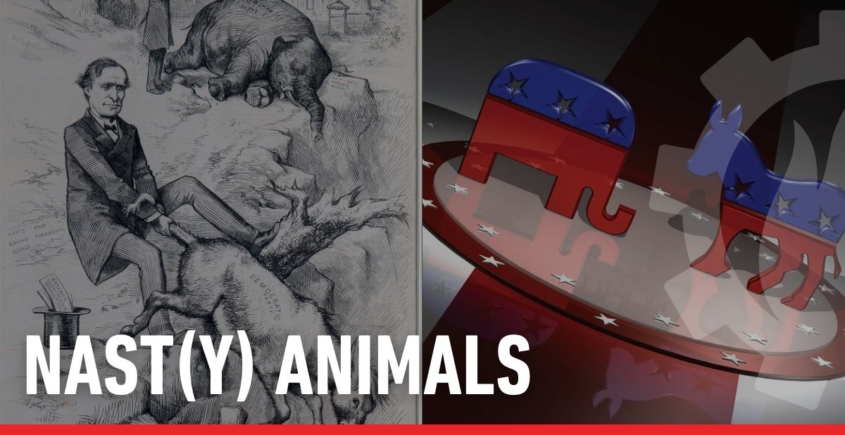Nast(y) Animals
Hopefully, by now, everyone has come to terms with the results of our most recent elections. Whether you voted for or against the eventual winner, congratulations on voting! (I wrote this before election day, so I don’t know any outcomes — guessing winners and losers can be real PIA (Pain in the @%$) Jobs). For the most part, for decades, our elections have been dominated by two major parties, Republicans and Democrats, the reds and the blues — or better yet, the elephants and the donkeys. These iconic animal symbols of our two major political parties have become widely recognized (red and blue with stars), but their origins and the stories behind them are less well-known. I did some digging, and found out a political cartoonist named Thomas Nast, working for Harpers Weekly at the time, was the originator and catalyst behind these images, Here’s a deep dive into the history and fun trivia about these political mascots. Thanks to amazon.com, thomasnast.com, smarthistory.org, nyhistory.org, youtube.com, and Wikipedia for the info.

The origins of the “Democratic Donkey” date back to the 1828 presidential campaign of Andrew Jackson, the party’s first official presidential candidate. Jackson was a populist known for his rough-and-tumble personality, which earned him the nickname “Jackass” from political opponents. Rather than reject the label, Jackson embraced it, using the donkey as a symbol of his stubborn, determined nature. This early association between Jackson and the donkey gradually became linked with the Democratic Party, but it wasn’t until decades later that it became an official emblem.
The real cementing of the donkey and elephant as political symbols came in the 19th century, thanks to the work of a German-born political cartoonist named Thomas Nast. Nast, considered the father of American political cartooning, who worked for Harper’s Weekly and created some of the most famous depictions.
Nast first used the donkey in 1870 as a stand-in for Democratic critics of the Civil War’s outcome. He depicted a donkey kicking a dead lion, symbolizing the Democratic press’s attacks on the late Edwin Stanton, Abraham Lincoln’s Secretary of War. The image struck a chord, and soon the donkey became a shorthand symbol for the Democratic Party.
Nast is also responsible for the Republican elephant. The first appearance of the elephant occurred in an 1874 cartoon titled “The Third Term Panic.” At the time, there was widespread speculation that Ulysses S. Grant, a Republican, might seek a third presidential term, which alarmed both Democrats and some Republicans. In the cartoon, Nast depicted various groups frightened by a rampaging elephant labeled “The Republican Vote.” The image showed the elephant barreling toward a trap set by a donkey dressed as a lion, symbolizing the Democratic press attempting to stir fear. The idea of the Republican Party as a powerful but often lumbering elephant stuck and was used more and more frequently in political imagery, eventually becoming the party’s official symbol.
Nast employed the elephant to represent Republicans in additional cartoons during the 1870s, and by 1880 other cartoonists were using the creature to symbolize the party.
Despite their continued use as political symbols, neither the Democratic Party nor the Republican Party officially adopted the donkey and elephant as their mascots. It was primarily through public perception, reinforced by Nast’s cartoons, that these animals became shorthand for the two parties.
Thomas Nast was a genius at using humor and exaggeration in his cartoons. His depiction of the elephant as bumbling and the donkey as reckless was not intended to be flattering to either party. Both animals were often depicted as out of control, symbolizing political chaos.
While the donkey and elephant are the most famous, they’re not the only animals to have represented political movements in U.S. history. For example, during the 1850s, the short-lived Know-Nothing Party was symbolized by an owl. The owl represented secrecy and wisdom (or lack thereof), a nod to the party’s semi-secretive nature – see cartoon on Irish and German immigrants at the time stealing the elections.
Thomas Nast’s influence on American political iconography cannot be overstated. Beyond creating the Democratic donkey and Republican elephant, Nast is credited with popularizing other lasting symbols like Uncle Sam (and the modern image of Santa Claus. His political cartoons helped shape public opinion.
What began as insults and satire evolved into iconic symbols that still represent America’s major political parties over a century later. Despite their unofficial status, the donkey and the elephant have become a deeply ingrained part of U.S. political culture, embodying the differences—and sometimes the stubbornness—of America’s two-party system.
Worth a watch – (bit long but wonderful and insightful, especially the ending): Political Cartoonist Sean Kelly: Artist’s Talk: Elephants, Donkeys & Twitter Birds: How Cartoon Symbols Have Shaped Politics
To learn more, visit: https://www.zilliondesigns.com/blog/democratic-republican-logo-designs/






Leave a Reply
Want to join the discussion?Feel free to contribute!